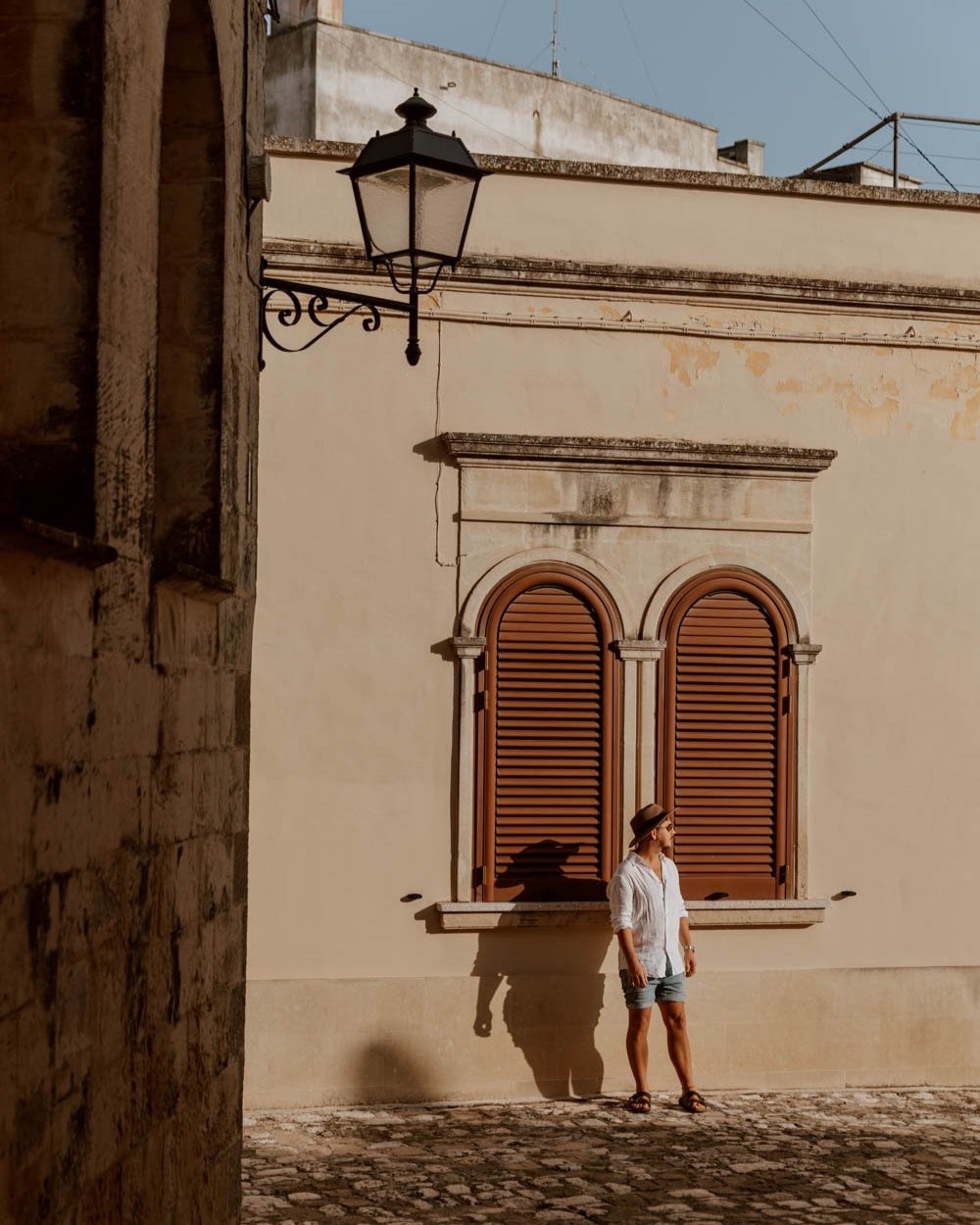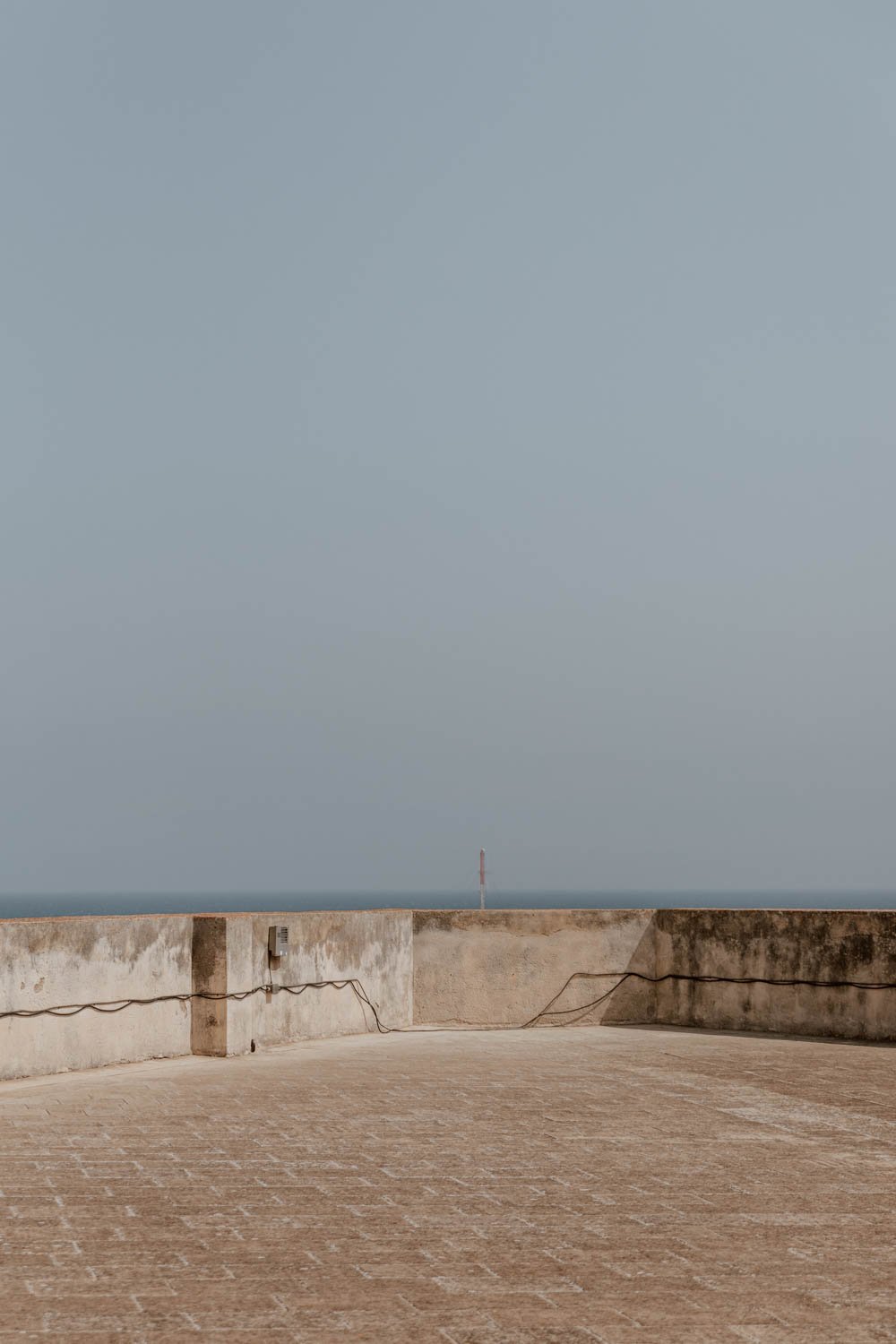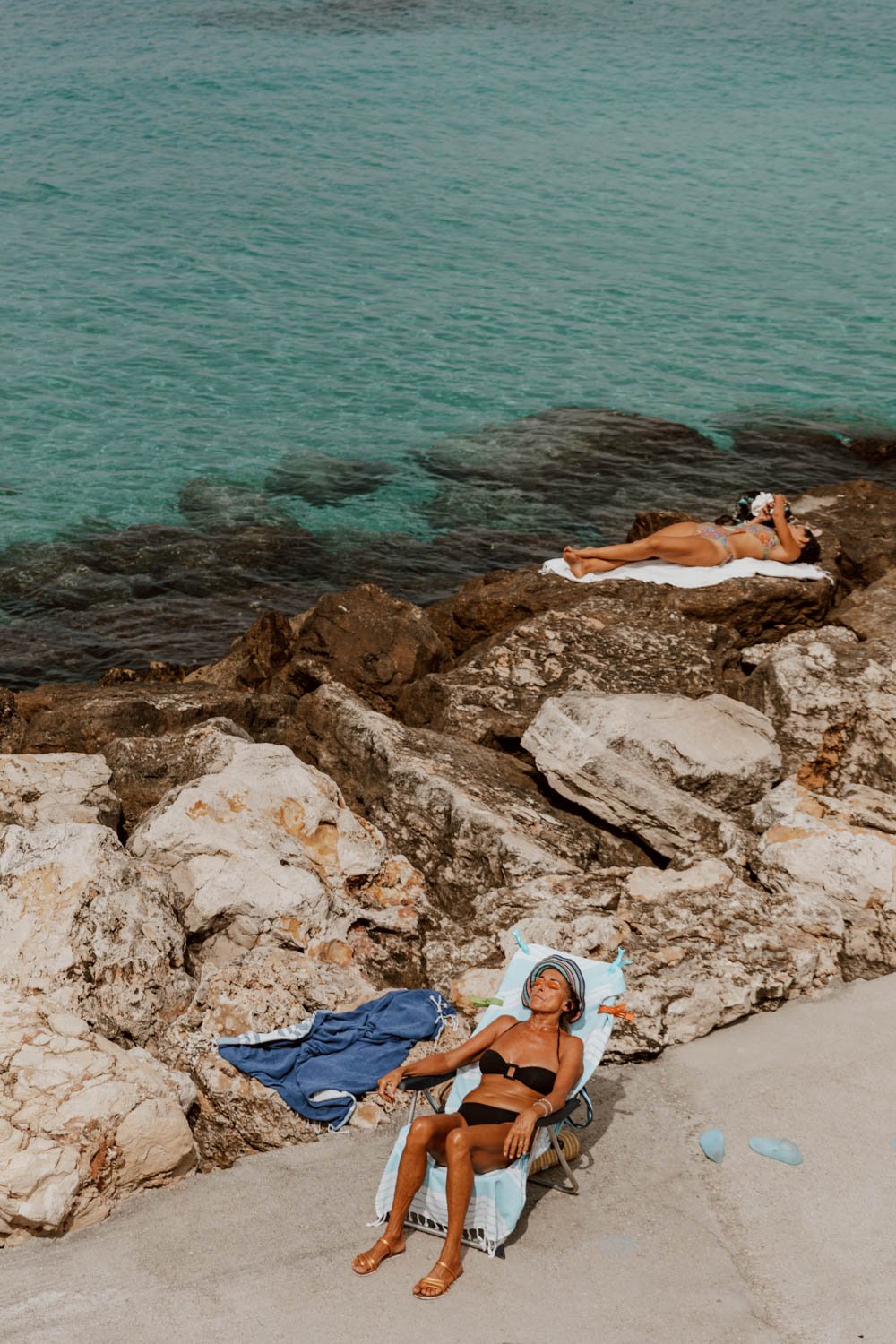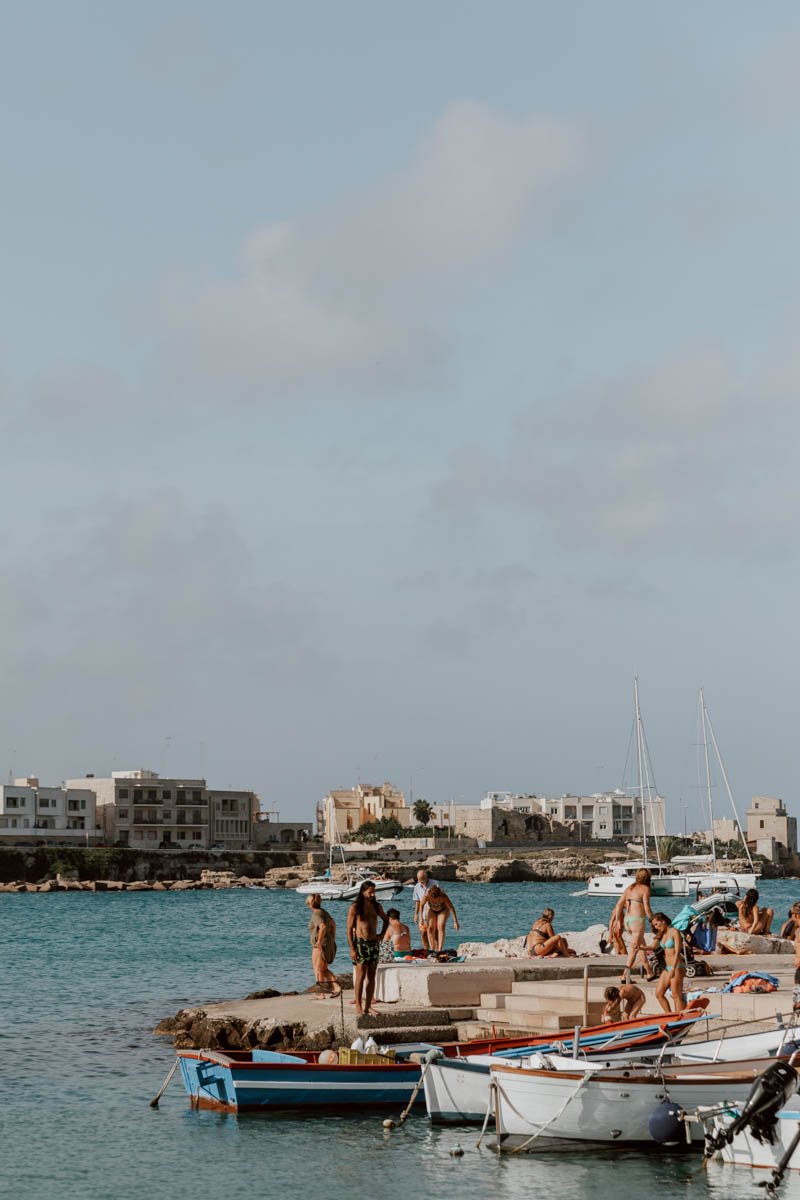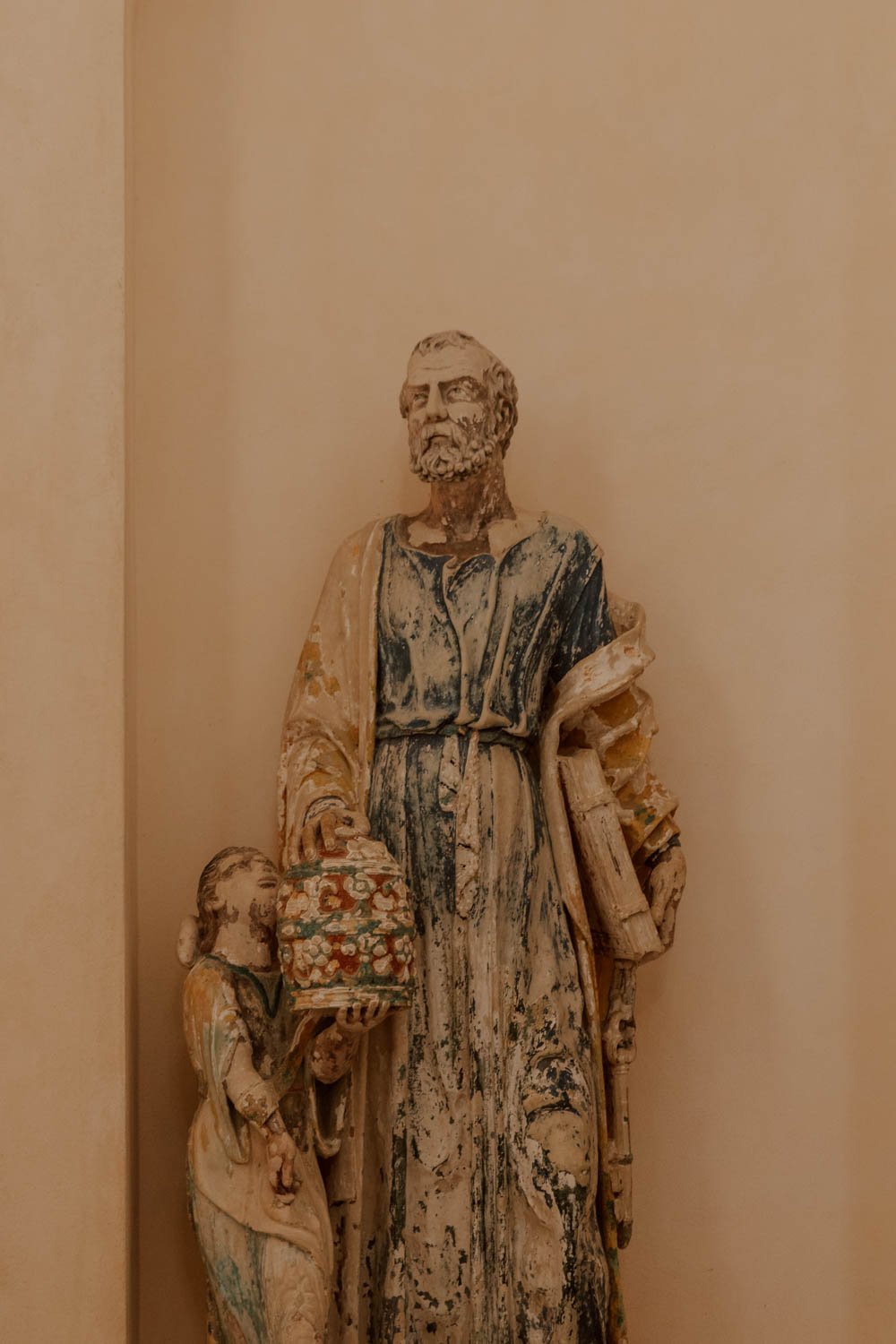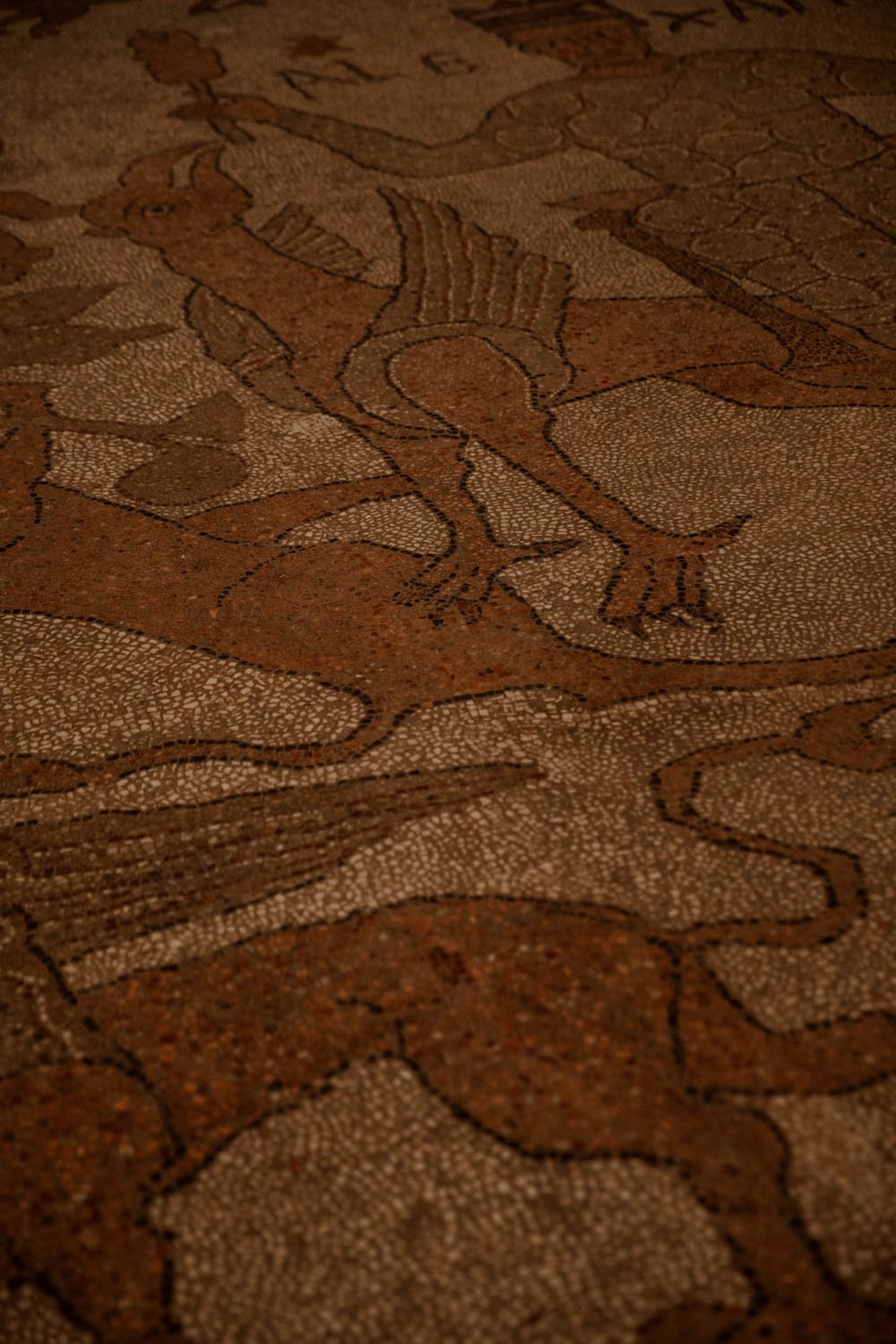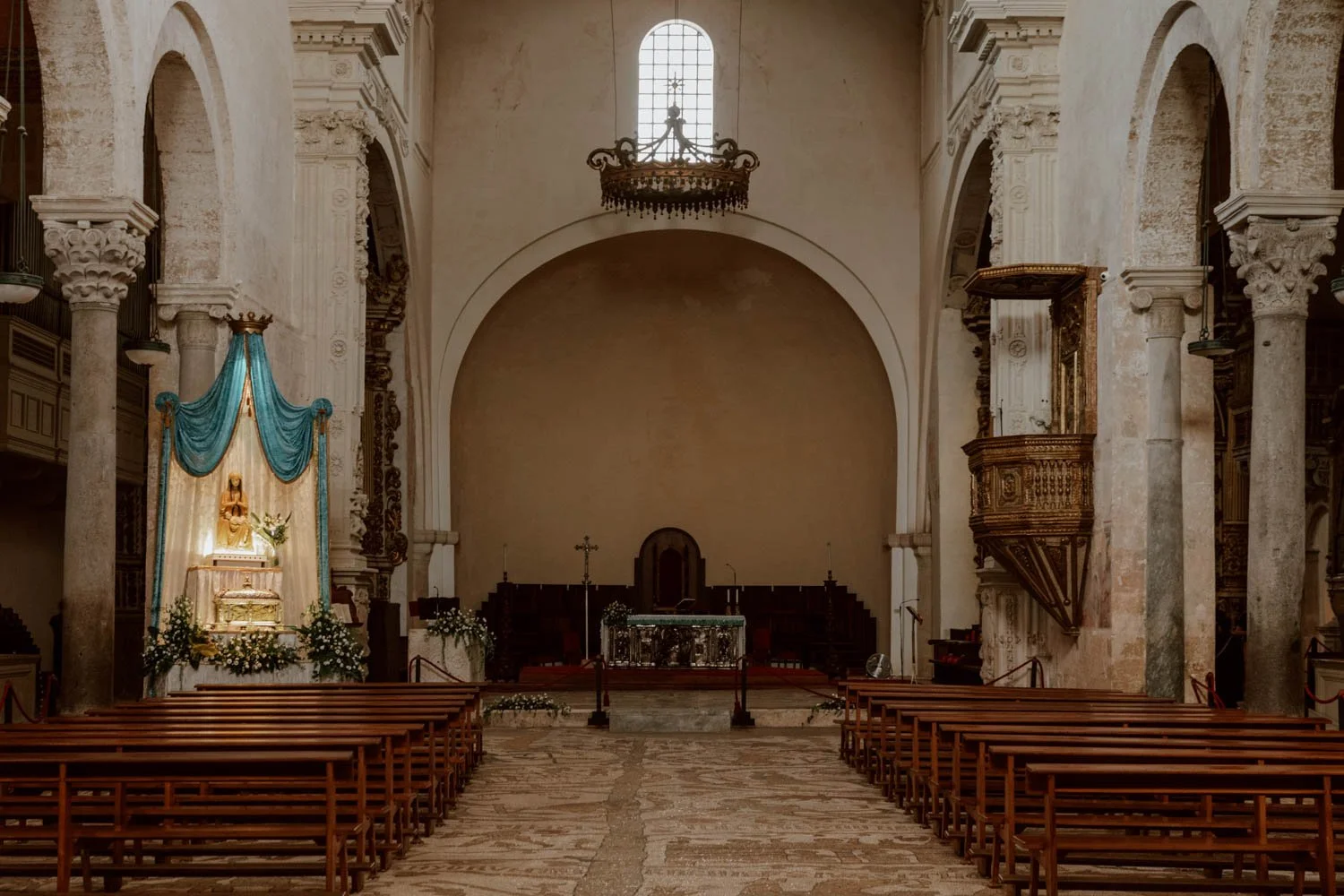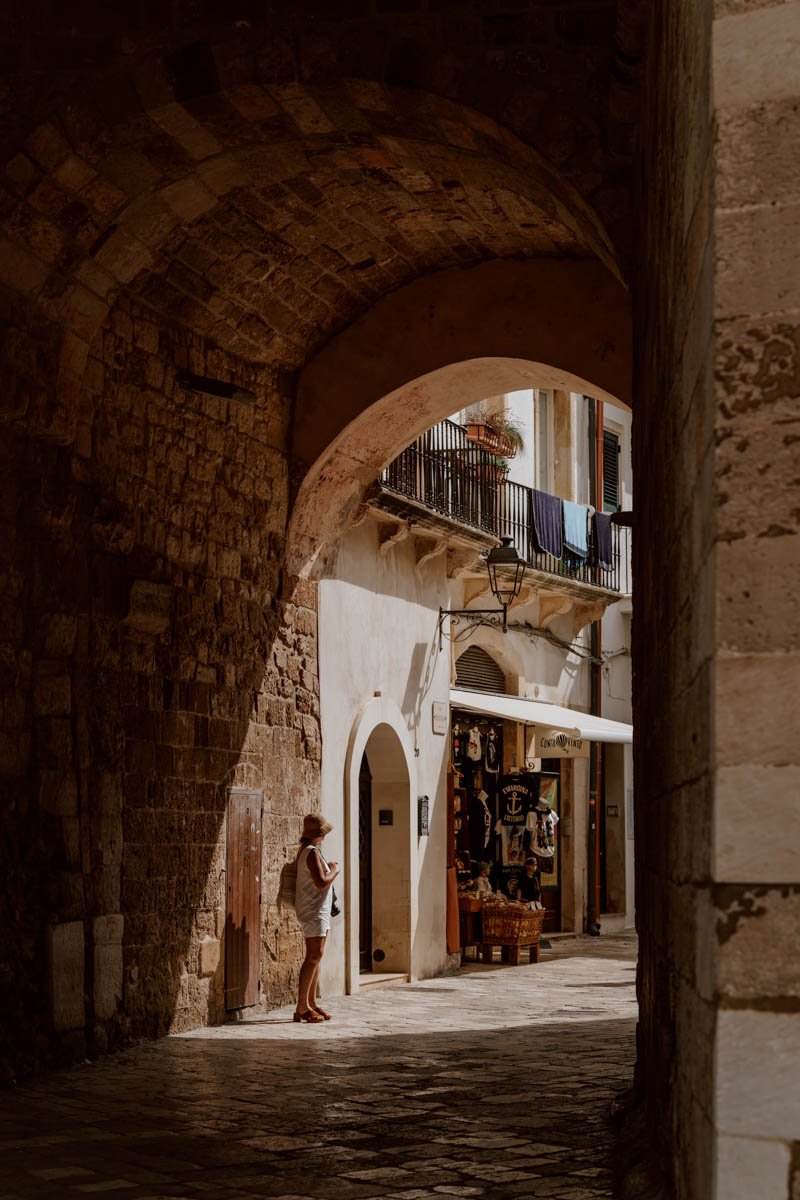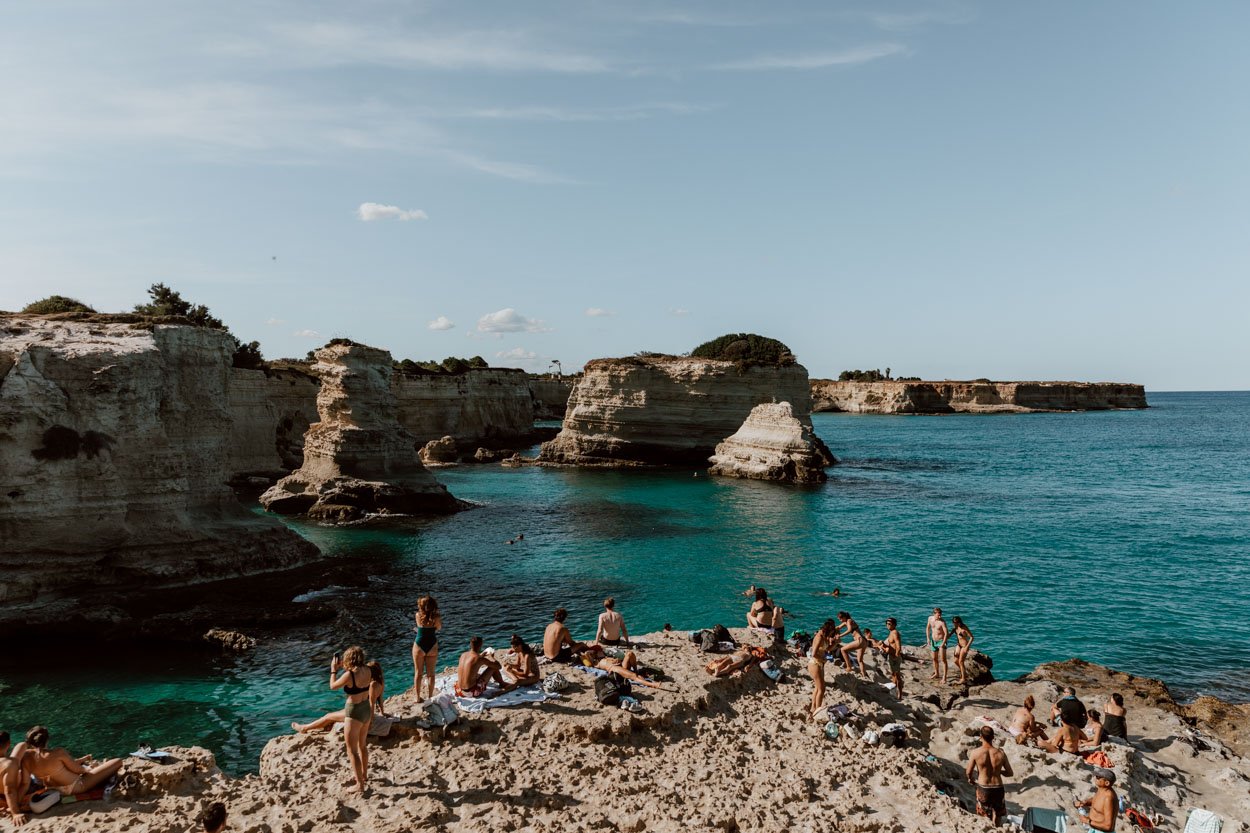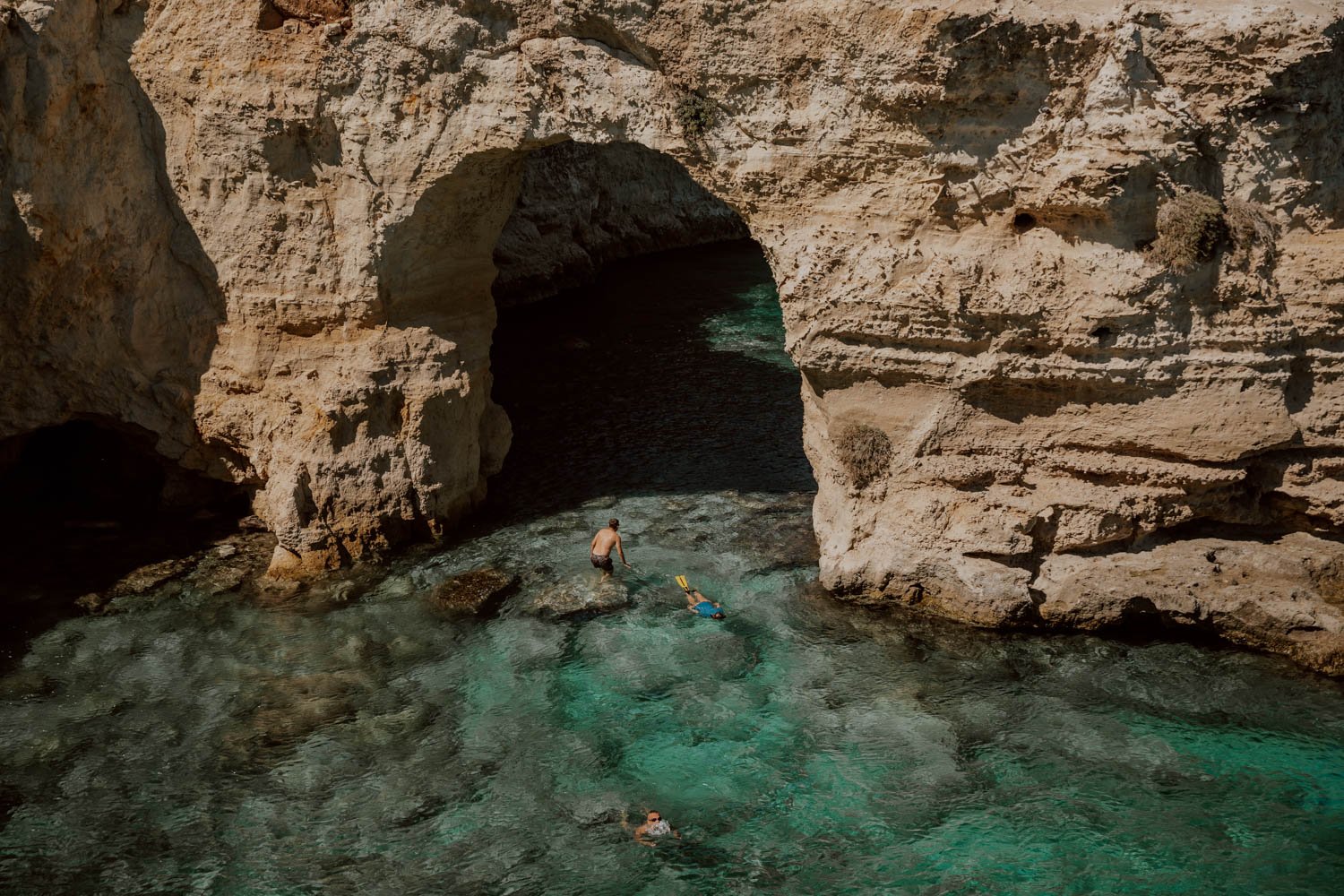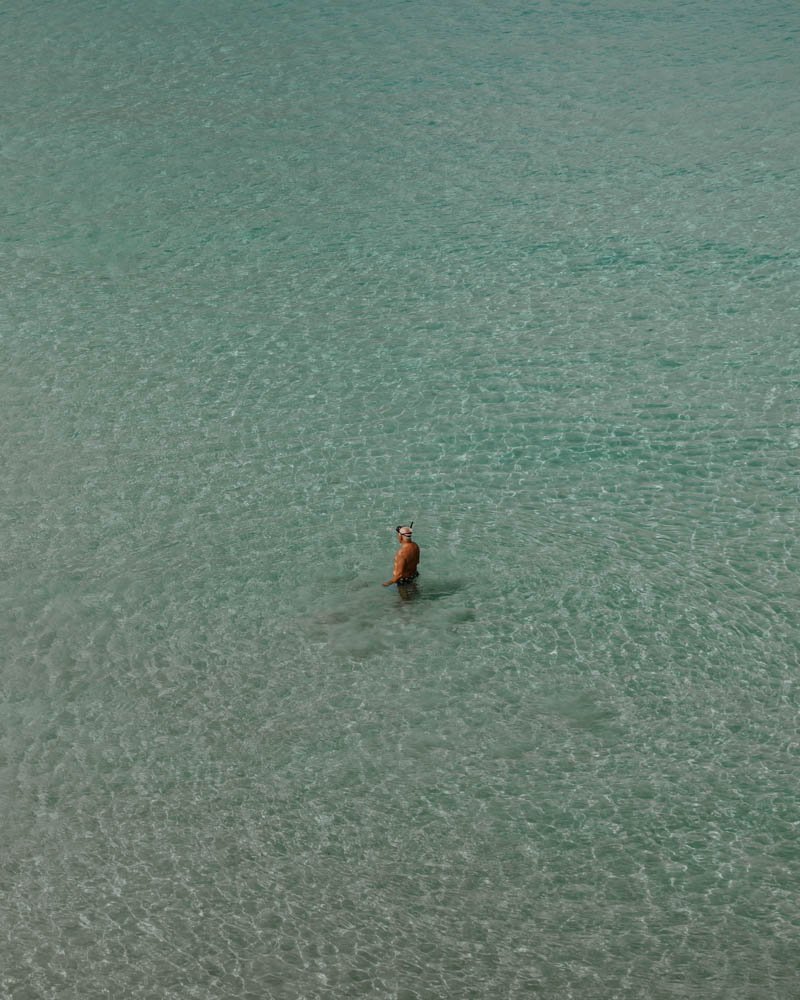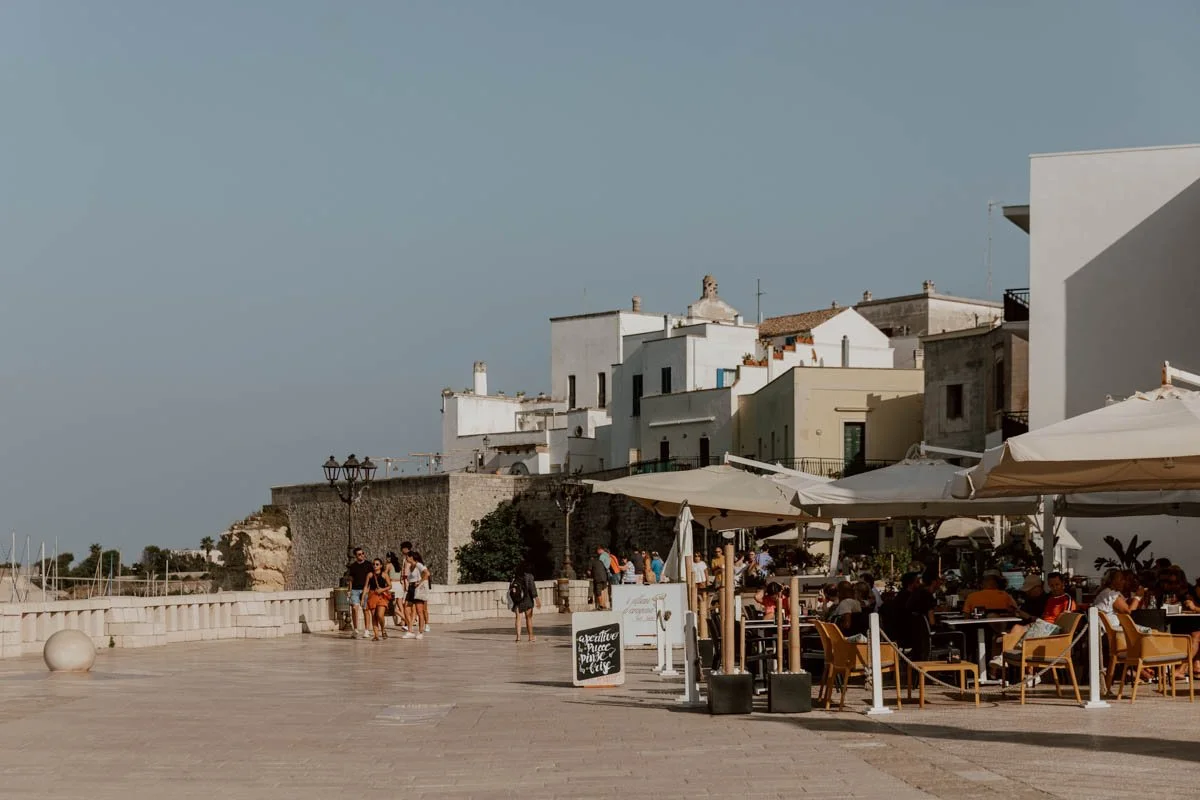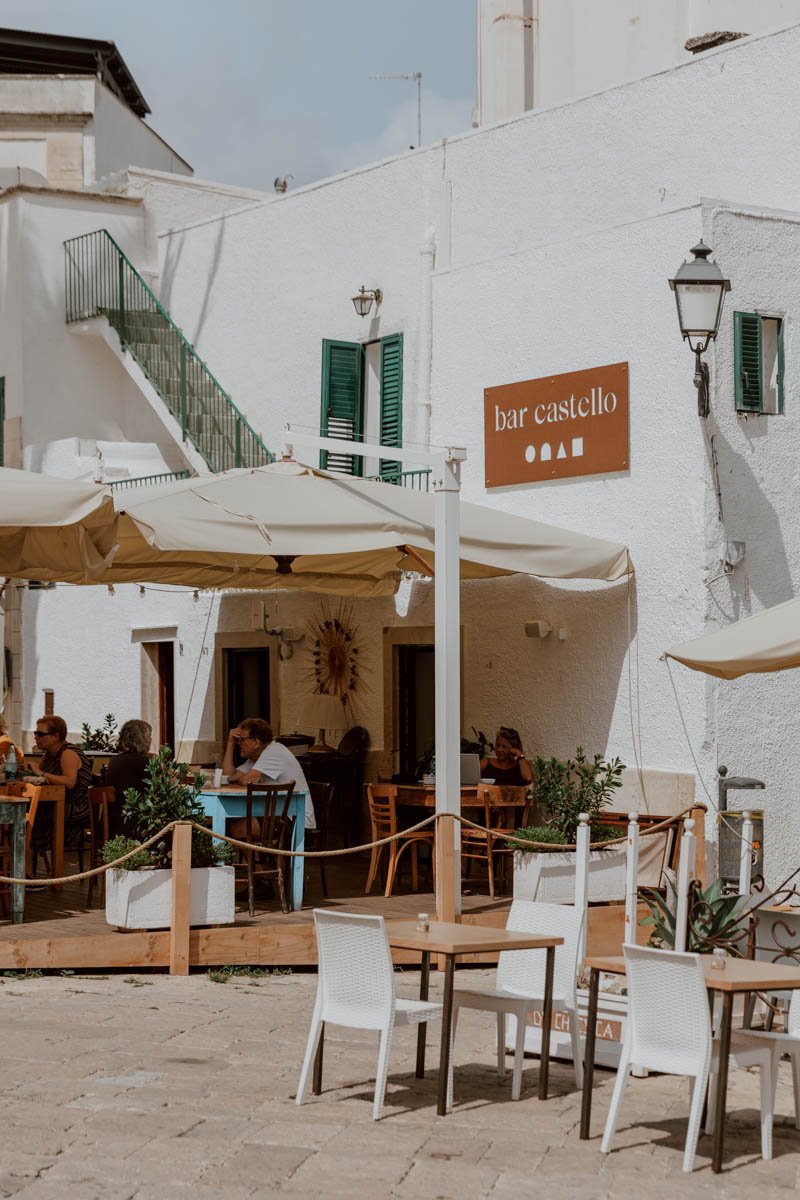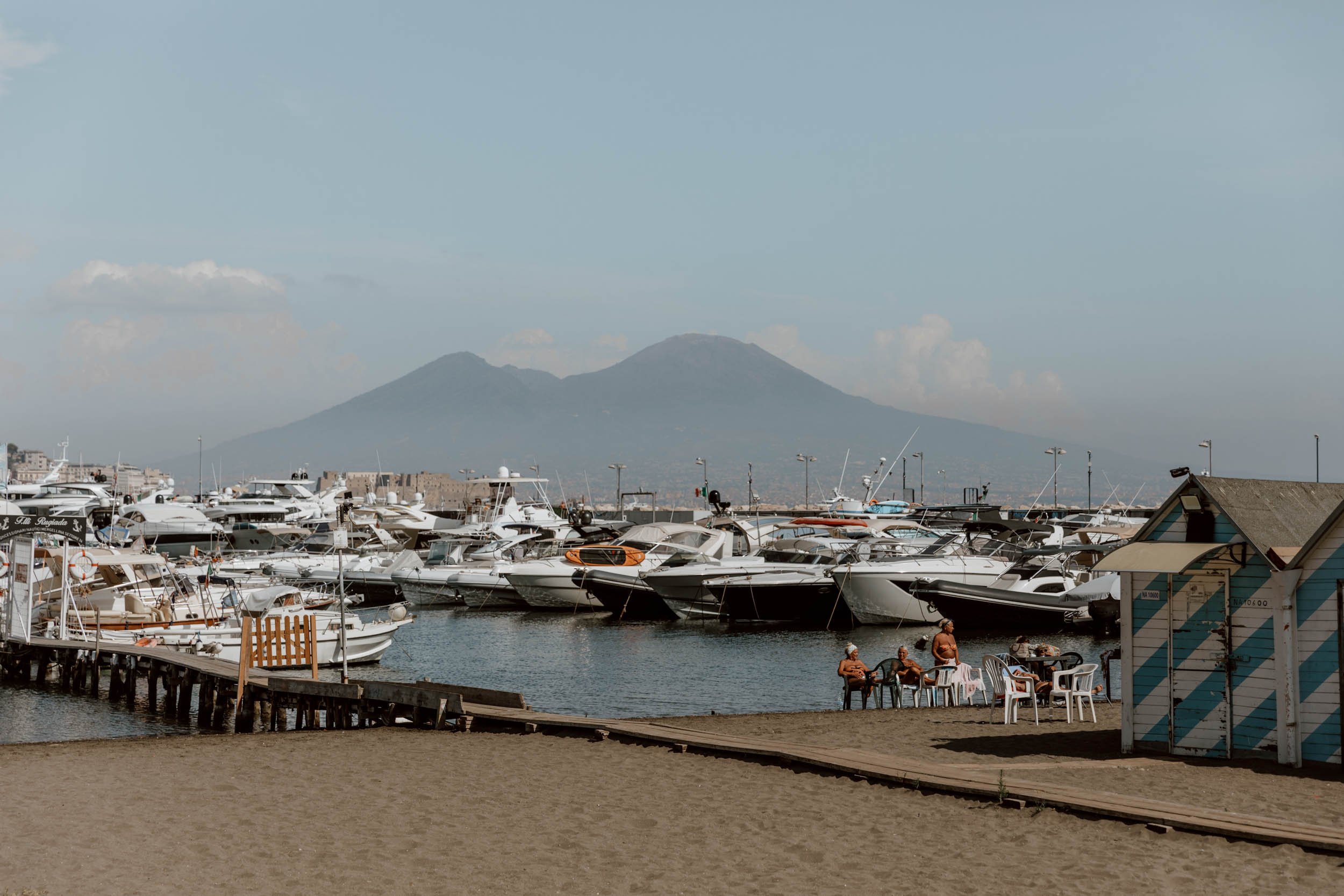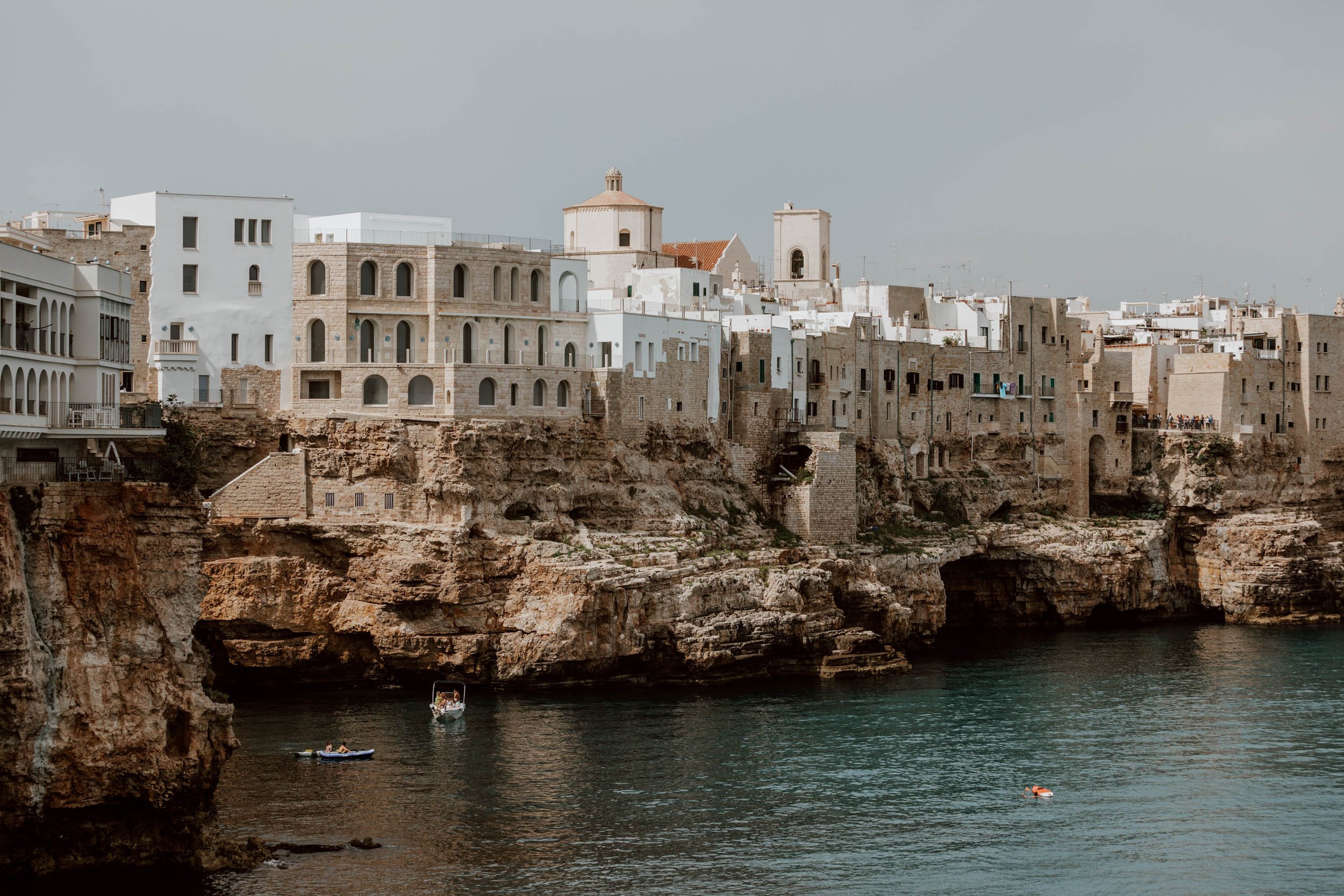After two visits to Otranto, we can happily say that this is one of our very favourite Puglian towns - and a must-visit for those vacationing in the region. In this guide we’ll share the best things to do in Otranto, including advice on where to eat, stay and things you can’t miss!
Sitting at a white plastic table along Otranto’s Lungomare, a chocolate cornetto and a cappuccino in front of me, and fast, strong accented barese breakfasting behind, it’s difficult to imagine a world in which this charming town - and indeed the entire region - was anything but Italian.
And yet, just over 500 years ago Otranto came under attack - and fell - to Ottoman forces. In a clash of faiths and civilisations, this town was the key battleground: the first in a long line of dominoes that needed to topple for Sultan Mehmed II to pursue his expansion into Western Europe.
The battle for Otranto was a bloody endeavour, and after a fifteen-day siege the inevitable happened - the walls were breached, and the Turkish army invaded the citadel, killing more than 12,000 people and enslaving another 5,000 as they went from house to house, sacking, looting and lighting the dwellings ablaze.
It was however upon the fates of the 800 men hiding in the cathedral that history would turn.
Offered the stark choice of converting to Islam or execution, a tailor named Antonio Primaldo Pezzula proclaimed "Now it is time for us to fight to save our souls for the Lord. And since he died on the cross for us, it is fitting that we should die for him".
His words, it seems, spoke for all, and two days later, after several more refusals to renounce their faith, the martyrs were led to the Hill of Minerva (later renamed the Hill of Martyrs) and beheaded.
The Ottoman rule of the decimated southern outpost was short-lived and upon the Christian-led retaking of the town, the bodies of those who sacrificed their lives were moved to the mosaic-filled Cathedral, where they are still revered today.
The Otranto you’ll visit today feels like a million miles away from such events: an increasingly popular summer destination for foreigners and local tourists alike, it offers gorgeous swimming and sunbathing spots, a cornucopia of excellent restaurants, seawall walks, and a real sense of the southern Italian dolce vita. But, peel your eyes away from such scenes, you can see that Otranto was rebuilt and redefined based on the paranoia of being the Achilles heel entry point for invaders from the Ionian Sea, with its defensive ramparts, fortifications, arches, and stronghold castle configured to ensure such a catastrophe could never happen again.
We were so excited to return here on our third trip to Puglia, and in this guide have shared everything you need to know to plan for Otranto, whether it’s a day trip, quick stop on your road trip, or holiday base in the region. As well as the best things to do in town, we’ve shared our pick of the best restaurants, accommodation, and aperitivo spots, plus advice on transport connections and parking.
the otranto essentials
Sunbathe / Otranto has some of our favourite city-based swimming spots in all of Puglia, and is close to some of the region’s best beaches.
History / Step back in time at Aragones Castle
Wander / Get lost in the historic centre independently or join a highly-rated walking tour
Sombre / Head beneath the Cathedral to the Chapel of the Martyrs
Byzantine / Discover at the frescoes in Chiesa di San Pietro
Do / Join a local for a three-hour home cooking class
Stay / Our hotel pick is Palazzo De Mori, & our favourite Airbnb, Il Balconcino di Otranto
The Most Wonderful Things to Do in Otranto
The Aragones Castle
From the exterior, the Aragones Castle is not the prettiest; however, we guess that was never the point.
Following the Ottoman invasion, and the eventual retaking of the city 13 months later, it was decided that the castle should be fundamentally reconstructed and a stronghold built which could sustain a siege for weeks or months. Once bitten, twice shy it seems.
Having survived the intervening centuries, today it is the main arts + culture venue of the town.
On the ground floor one can find a detailed account of the history of the castle and its improved fortifications, alongside a small display on ‘The Castle of Otranto’ by the exquisitely named Horace Walpole; published in 1764, it’s widely regarded to be the first Gothic novel.
The upstairs area is reserved for temporary art exhibitions, and when we visited there was a remarkable ‘Other America's’ photography exhibit by Sebastião Salgado - we loved it so much that we bought this coffee-table book of it. There smaller, side exhibits by other artists weren’t at the same level, but it’s a good indication of the calibre of artist that Aragones Castle can attract for summer shows. For 2023, the works of Russo-French artist Mark Chagall form the main exhibition.
Another selling point of the castle are its panoramic rooftop views which are good, but not as amazing as you may hope.
Aragones Castle is open all year round, but visiting times vary depending on the time of year. In the summer months, it tends to be from 10am-9.40pm, but we recommend checking here before planning your visit.
The real limitation on how much the average tourist will enjoy this attraction unfortunately comes down to price. Tickets cost €12 per person, which we honestly feel is far too much for what is on offer. For this reason, we highly recommend confirming what the temporary art exhibits and installations are before buying your ticket; we adored Salgado’s work and were happy to pay but if there’s nothing on that you’d particularly like to see, it may not be worth it.
Tickets can be bought upon arrival, and there is no need to make a reservation in advance.
You can find Castello Aragonese here on Google Maps.
enjoy some city-based sunbathing
Composed of several crescents of powdery soft sand, a variety of cement outcrops and man-made rocky wave-breakers, this Otranto offers up some of our favourite swimming spots in Puglia.
Indeed, one of the moments Andrew was most looking forward to on our third trip to the region was the chance to have an afternoon making the most of them, and it was a big factor in spending a few nights staying in the town.
There are several very distinct sunbathing / lido areas within Otranto’s historic centre, beginning from the most westerly point of the city:
Spiaggia dei Gradoni | Around a 10-15 minute walk along the seafront from the centre of Otranto, the powdery white sand of Spiaggia dei Gradoni makes it the city’s best beach in the eyes of many - especially for those that prefer sand over rocks. The vast majority is free beach, although a small lido offers parasol and sun bed rental. Find the beach here.
Lido Camillo | This small lido is located on a small section of beach between two restaurants - here on Google Maps. It’s a popular place to rent a couple of beds for the day (around €35 to €40) but can get a little cramped during peak season.
Spiaggetta Del Molo | This section of free beach located just below the town walls is popular with families due to the shallow, bath-like clear waters that lap fine and soft sand. With no lidos, it’s ideal for those that just want to chuck a towel down for a few hours (and need something soft beneath their back). That said, there is a small harbour to the eastern edge of this beach which we found to be a delightful spot for a few hours under the sun.
You can find this beach here on Google Maps.
This is an ideal spot to bring your own puce snack and chilled beers, but if you’re caught short, there’s a small kiosk in the nearby park selling cold bottles of Peroni for €4. There’s also a toilet underneath the ramparts if you get caught really short!
Lungomare | This section (which although we’ve called it the lungomare, it’s actually just a concrete walkway that runs parallel + below it until you reach the harbour) was by far the most popular place to swim, relax and top up your tan - especially amongst the Italians who don’t feel the need to write off a perfectly good spot in the sun simply because there’s no sand! As throughout the rest of the bay, the water is relatively shallow and calm, and the most gorgeous of turquoises.
Find this section here.
If you’re here on a day trip, then we’d suggest the Lungomare and Spiaggetta Del Molo as the best picks for a couple of hours swimming and sunbathing. However, if you prefer a traditional sandy beach, or haven’t yet adjusted to the Italian way, Spiaggia dei Gradoni may be better for you.
Don’t know what a lido is? Read our explainer guide: The Art of The Italian Lido
Chiesa di San Pietro
Hidden between the unassuming narrow streets of the city’s old town, not far from the bastions overlooking the harbour, stands a remarkable little Byzantine church dedicated to Saint Peter.
Built in the 10th century (although some trace its origins back as far as 400 BC) atop what would have been the city’s highest point, it is the oldest church in Otranto. And whilst rather modest from the exterior, within its walls it holds some of the most important examples of Byzantine frescoes in all of the region.
Though only a patchwork of the original works remain, following significant restoration efforts in 2012 and 2013, those that do are remarkably vibrant and detailed. For us, stopping by this small, understated treasure of Otranto is an absolute must.
Visiting Chiesa di San Pietro | The church is open from 10am to 1pm, and then again from 4.30 pm to 7.30 pm during the summer months. There are reduced opening times for the rest of the year, so we recommend checking here before visiting outside of April-October.
There is no entrance fee but donations are welcome. The volunteer working at the time of our visit spoke decent English and was passionate about sharing his insights on the frescoes, but they do also have information cards in various languages that are worth taking a look at.
You can find Chiesa di San Pietro here on Google Maps.
Take a Leisurely Stroll Along the Lungomare
The Lungomare degli Eroi, a pedestrianised walkway which traces a path along the bay of Otranto, is a delightful place to take a passeggiatta - the Italian tradition of a walk in late afternoon, early evening - before heading for an aperitivo.
You’ll naturally stumble upon it, and the beautiful turquoise waters that lap its edge, on your wanderings through the city, but we’d make a point of following its entire course at least once.
Top Tip // Once you reach Giardini pubblici "La Villa", keep the sea on your right and continue walking along Via Lungomare Kennedy to Cappella della Madonna dell'Altomare (maps) for an excellent view back over the city from the the other side of the bay.
Admire the Cathedral
Built in 1068 atop the site of an early Roman temple, Otranto’s Cathedral is rather muted when viewed from the exterior. Indeed, upon entering, eyes tracing the walls toward the altar, you could be forgiven for thinking that this was not a cathedral at all.
Until, that is, that those same eyes find the ceiling or floor.
Above, a constellation of golds, and below the most intricate mosaics created by a young monk named Pantaleone. Depicting his vision of heaven and hell, the mosaic was considered so impressive that even the Muslims who desecrated the church (and many of the 13th century mosaics) after the Siege of Otranto couldn’t bring themselves to fully destroy such a work of Christian art.
A large section of the mosaic is roped off (save for the benches of the congregation) but from the entrance it’s possible to gain a fantastic vantage point. In comparison to the famous mosaic floor of Siena, Otranto’s definitely flies under the radar, but is worth going out of your way to make time for it.
As impressive as the mosaics are, it is the sombre and dimly-lit crypt dedicated to the 800 souls who lost their lives in the infamous Turkish massacre for which the cathedral is most renowned. Their skulls and bones are immaculately arranged in an intricate pattern, a visual reminder to the religious and cultural significance of Otranto, as well as the resilience and strength of its martyrs.
The Details | You can find Otranto Cathedral here on Google Maps. It is open 8 am-12 pm and 3pm-7.15 pm every day, and is free to enter. Do be aware that this remains an active place of worship, so women and men should dress and appropriately. Take hats off on entry, don’t wear beach clothes, and give space + silence to those here to pray.
Additionally, please be especially respectful when visiting the crypt.
Explore the Historic Centre
Beyond the Cathedral, the castle, and the Chiesa di San Pietro lies a rabbit warren of narrow alleys and hidden corners, and even on a busy summer’s day you can find respite from the crowds and step back in time in this ancient town, recognised by UNESCO in 2010.
It’s actually quite compact, with Otranto’s size enhanced significantly by the relatively modern additions of the lungomare, marina, and areas stretching out along the coast.
To really appreciate Otranto’s historic fortified centre however, we highly recommend setting the alarm clock a little earlier and taking a wander before the day trippers and slumbering holiday makers arise (the downside to Otranto is how busy can become at times in the narrow central streets of the historic centre around lunch and dinner). When it all becomes a bit too much, or a cruise ship has docked nearby, we suggest just seeking out the sea views and light breeze by heading away from the central thoroughfares and down to the lungomare, the walls (maps), or finding a quieter whitewashed side street or piazzettas.
Don’t miss Porta Alfonsina - an entrance through the town walls made after the Ottoman invasion - and the Monument to the Martyrs of Otranto, a statue created by Italian sculptor Antonio Bortone to remember those who lost their lives (as well as the restaurants and bars we recommend later in the post!)
Travel Tip // Otranto’s centro storico is the perfect compact size for a solo wander, but if you’d like to understand a little more about the city’s history, consider joining this highly-rated two-hour walking tour.
Hit Up the Nearby Beaches
If you’re thinking of basing yourself in Otranto for a few days on a Puglia road trip, the excellent beaches and swimming spots you can access within 30-minute drive may seal the deal.
We can personally recommend the following:
Porto Badisco (maps) | This gorgeous little cove - with the most incredible water - has no beach, but that didn’t stop us enjoying a delightful hour reclining atop the rocks that line the edge. There’s a small lido if you demand a flat surface to lie upon, as well as several nearby restaurants. On the road, Bar Alimentari Tabacchi da Carlo has the most perfect signage and is good for a pit-stop too. Find it here, around a 20 minute drive south of Otranto.
Torre dell’Orso | Fringed by pine forest, and enclosed by cliffs on both sides, the long stretch of sandy beach at Torre dell'Orso is ranked by many as one of the best beaches in Puglia, with the village itself a popular holiday base. We personally didn’t love the town (which shares the same name) but there’s no denying that the long expanse of powdery white sand is a wonderful place to throw down a towel for the day - or enjoy one of several lidos that have found a permanent home at the water’s edge. In peak summer, note that this beach does become more ‘packed’ than many others in Puglia, but may offer exactly what you want due to the number of facilities on it.
Find out more in our short guide to Torre dell’Orso
Note that it’s next door to Grotta della Poesia (Cave of Poetry), once the most famous Insta-place in Puglia. However, significant recent changes to create an archaeological site mean swimming there is no longer permitted. Find out more in this post: A Short Guide To Rocca Vecchia
Baia di Turchi (maps) | Backed by dense pine forests, and a few kilometres from the designated car parks, Baia dei Turchi is a beach you have a to work a little to reach - which you’d think would make it a less popular option for those looking for a day out under the sun. However this stunning stretch of soft, white sand located within the protected Oasis of Alimini Lakes (and boasting both the Blue Flag and 5 Sails awards) continues to be a firm favourite for those holidaying in the Salento region in Puglia.
I Faraglioni di Sant'Andrea (maps) | One of our very favourite swimming spots in all of Puglia, this ‘beach’ is much more a collection of hewn-out crevices within the limestone stacks and coastline, worn smooth by waves over time and surrounded by the most beautiful kaleidoscopic blue water, than what many of you will consider a traditional beach. We absolutely adore this place but if you - or your back - value a flat surface, it may not be ideal.
Keep Reading // Discover the best beaches in Puglia (including all our favourites)
Where to Stay in Otranto
Otranto Airbnbs
Cottage Donna Pina | This super popular little cottage in the heart of the old town (but hidden away in a quiet street) is small but perfectly set up for a couple. Excellently priced and benefits from a little patio garden. Find out more here.
This host actually has several excellent little Airbnbs in the centro storico, all with excellent reviews - you can see all the listing here.
Il Balconcino di Otranto | The beautiful two-bedroom apartment is one of our favourites! Relatively modern throughout, it’s beautifully furnished with lots of unique art and nautical objet d’art, alongside select pieces of vintage furniture. The location is excellent, in the heart of the centro storico, with an enchanting view of the Byzantine church of San Pietro from the cute little balcony. Find out more here.
A handful of our other favourites include: Le Nicchie, Romantic Studio, La Piccinna and U Purpu.
Janela Blue | Three one-bedroom apartments within a historic building (modernised but with period features like vaulted roofs) costing less than £80 per night in the high season. Super popular options in Otranto. See the individual listings for more details: Civico 35, Terraced Apartment and Civico 27
If your priority for an apartment is an incredible terrace upon which you can dine, sunbathe and enjoy wonderful Otranto views, we can recommend taking a look at this two-bedroom historic house the one-bedroom Palazzo Borgomonte (the terrace on this one has major ‘summer in Puglia’ vibes) or Magnificent Penthouse with sea view.
Dimora Lopez and Riva Mediterranea Domus are two large, absolutely stunning properties which are at a pretty high price point, yet are brand new so have no reviews. For this reason we can’t wholeheartedly recommend them, but felt they deserved a wee mention!
Otranto Hotels & Guesthouses
Palazzo De Mori | Once owned by Michele Leondari, one of the 800 martyrs murdered following the Ottoman invasion, this historic palace has been beautifully restored whilst maintaining its period features. The rooms are light, bright and airy with gorgeous white linens, tiled floors and antique furniture. One real highlight is the stunning view of Otranto’s harbour from its private terrace. Find out more here.
A super popular option is the pink-walled and nautical themed Corte Di Nettuno. The decor isn’t quite our cup of tea but it’s a super popular, highly-rated mid-range option in the heart of Otranto.
Alternatively, if you fancy a resort-style experience, but within walking distance to Otranto, take a look at Relais Valle Dell'Idro.
Hotel San Giuseppe Dimora Storica | Offering simple but stylish and contemporary rooms, this hotel is located in the historic centre, within the walls of sensitively restored 16th century farmhouse. It’s just 300m from the sea and offers surprisingly affordable rooms for its 4* status. Find out more here.
If you’re looking for a budget-friendly option we can recommend B&B Ophelia and Hotel Albània. Both are located at the edge of the historic centre, offer simple clean nd comfortable rooms and have excellent reviews.
Hotel Miramare is a good budget option if you are visiting outside of the popular months of July and August - during these months the prices charged are considerably than they should be given the standard of the rooms.
Top Tip // If you don’t mind being a little outside of the city, consider staying in Baglioni Masseria Muzza, an absolutely stunning luxury masseria that allows you to enjoy the surrounding countryside whilst also being just a short drive to many of the area’s most popular attractions.
A good alternative is Masseria dei Monaci.
Where to Eat & Drink in Otranto
Restaurants along the seafront and across Otranto more generally are, understandably, heavily seafood influenced but vegetarians will usually be able to find at least a couple of meat-free pasta dishes on most menus.
Our recommendations for restaurants and bars in Otranto include:
L'Ortale Ristoro Salentissimo (maps) | This gorgeous little deli hides a secret - a private rooftop terrace where you enjoy the most wonderful aperitivo. They have a fantastic wine list, the platters are tasty and fresh and they even do a local wine tasting. Highly recommend!
Maestrale (maps) | Wouldn’t necessarily recommend heading here for food or in the day, but its location right on the waterfront makes it a wonderful place to watch the sunset with a spritz in hand!
Retro Gusto | We didn’t eat here, but it’s the only restaurant in Otranto that makes it into the Michelin guide so one to have in the back pocket if you’re craving a more foodie-sort of experience.
Alternatively, Icon Restaurant - located here, right by the castle - is a great alternative. Widely considered to be one of Otranto’s best restaurants, it offers a popular tasting menu whilst the a la carte is really quite good value for the quality of the food (especially when compared to standard tourist fare around the city)
Classe 80 (maps) | Just a short walk from the historic centre (and therefore not suffering from bloated prices), this excellent seafood restaurant is a popular choice for those who want a more upscale dining affair.
L'Altro Baffo (maps) | Located along one of the historic centre’s quieter side streets, this contemporary restaurant has a strong focus on seafood, but with a creative and modern twist. Vegetarian options are limited but they usually have a meat-free orecchiette option.
Gelateria Fisotti (maps) | This artisanal gelateria has only been in business since 2012 but they’ve nailed it! Offering a variety of unique favours like pasticciotto leccese, but we discovered you just can’t go wrong with pistachio.
Friggitoria Otranto (maps) | There’s something truly delightful about eating a cone of freshly caught, freshly fried seafood whilst at the seaside - if this sounds like something you’d enjoy too, head here.
Sosta e Gusta Pucceria (maps) | Looking for a quick lunch? Grab a puccia from here - the simple mozzarella, fresh tomato and rucola option was delicious!
Spinnaker (maps) | We’re in two minds whether to recommend this as the cocktails were really quite mediocre (and relatively pricey) but the sunset views and setting were wonderful - and it remains one of Otranto’s most popular aperitivo spots. If you’re in Otranto for a couple of nights, definitely check out Spinnaker but perhaps stick to wine or beer.
Top Tip // If you’ve got a couple of days in Otranto, consider joining this highly-rated, three-hour cooking class in a local's home, where you’ll learn how to create traditional recipes and taste everything you make (with wine included, naturally). Find out more here.
How To Get to Otranto Puglia
By Car | Both times we’ve visited Otranto, we have done so as part of a Puglia road trip, and have found that this is by far the best way to get around - especially the further south you head from Bari or Brindisi.
All major car rental companies operate in Puglia, alongside some less well known Italian companies; whichever you choose to go for, if travelling in high season be sure to book your car hire in advance - although the supply is large, it is finite, and Puglia is now a very popular destination!
We rarely go direct when hiring our road trip vehicles, instead preferring to use two popular rental aggregators to compare costs and find the best deal. The two companies we use are RentalCars and AutoEurope - both of which we have had only excellent experiences with.
At just under 30-minutes away, Otranto is commonly visited on a day trip from the baroque city of Lecce, but is easily accessible from other popular towns and villages nearby. It’s important to know about the parking situation though, and we’ve shared our advice in the next section.
Travel Tip // If you’re planning on renting a car during your time in Puglia, we highly recommend reading our post ‘Nine Essential Car Rental Tips for Travellers’, for general tips on how to save money on your car hire and avoid some common vehicle rental mistakes, as well as our specific post on driving advice for Puglia, alongside our road trip itinerary.
By Train and Bus | Otranto is absolutely accessible with public transport, but irrespective of where you’re travelling from, your journey will likely involve at least one change (e.g. taking the train from Lecce requires a change in Maglie).
The small station is in the modern part of Otranto, about a 15-minute walk from the heart of the old town. Find it here on Google Maps.
You can check train times and book tickets on the Trenitalia website, or alternatively both train and and bus options are available on the Omio site.
Private Transfer | If you’re based in Lecce and don’t plan on hiring a car, you could consider booking a return private transfer, giving you the time to discover Otranto independently on a full-day trip. Find out more here.
Parking in Otranto
There are several large, all day car parks on the approach to the town (each charging around €4 to €5 for the day in summer) and the most convenient option for day trippers is to simply make use of these, especially if arriving after 10am or so, as any empty on-street parking space near the historic centre will already be taken.
This will also remove the stress of negotiating the several one-way routes around the city to avoid ZTLs (streets that are only legally accessible by residents, and that come with hefty fines for tourists that don’t realise or ignore the signs) and prevent you going round in circles for longer than you may hope in search of a free space near the centre.
There are several paid car parks near the waterfront, including these two popular options: Parcheggio Le Palme and Parcheggio Sant’Antonio.
Note that the potential to have a 5-10 minute walk to your car isn’t rare in Puglia, and so shouldn’t disincentivse you from having Otranto as a base.
If you secure accommodation in the centro storico, and are arriving in Otranto with your own vehicle, you should contact your host in advance to confirm your best options. Some may have private parking or provide a permit (as ours did), whilst others may recommend where to park but you have to cover the cost and wheel your bags.
Where to Next?
14 Things to Know Before a Puglia Road Trip
16 Incredible Beaches in Puglia
Our Puglia Road Trip Itinerary
8 Reasons to Fall in Love With Puglia
17 Really Useful Things to Know Before You Visit Puglia
A Short Guide to Bari | Your Gateway to Puglia
A Short Guide to Polignano a Mare | Puglia’s Most Famous Beach




